Moroziv Village: Complete History from Ancient Times to Present
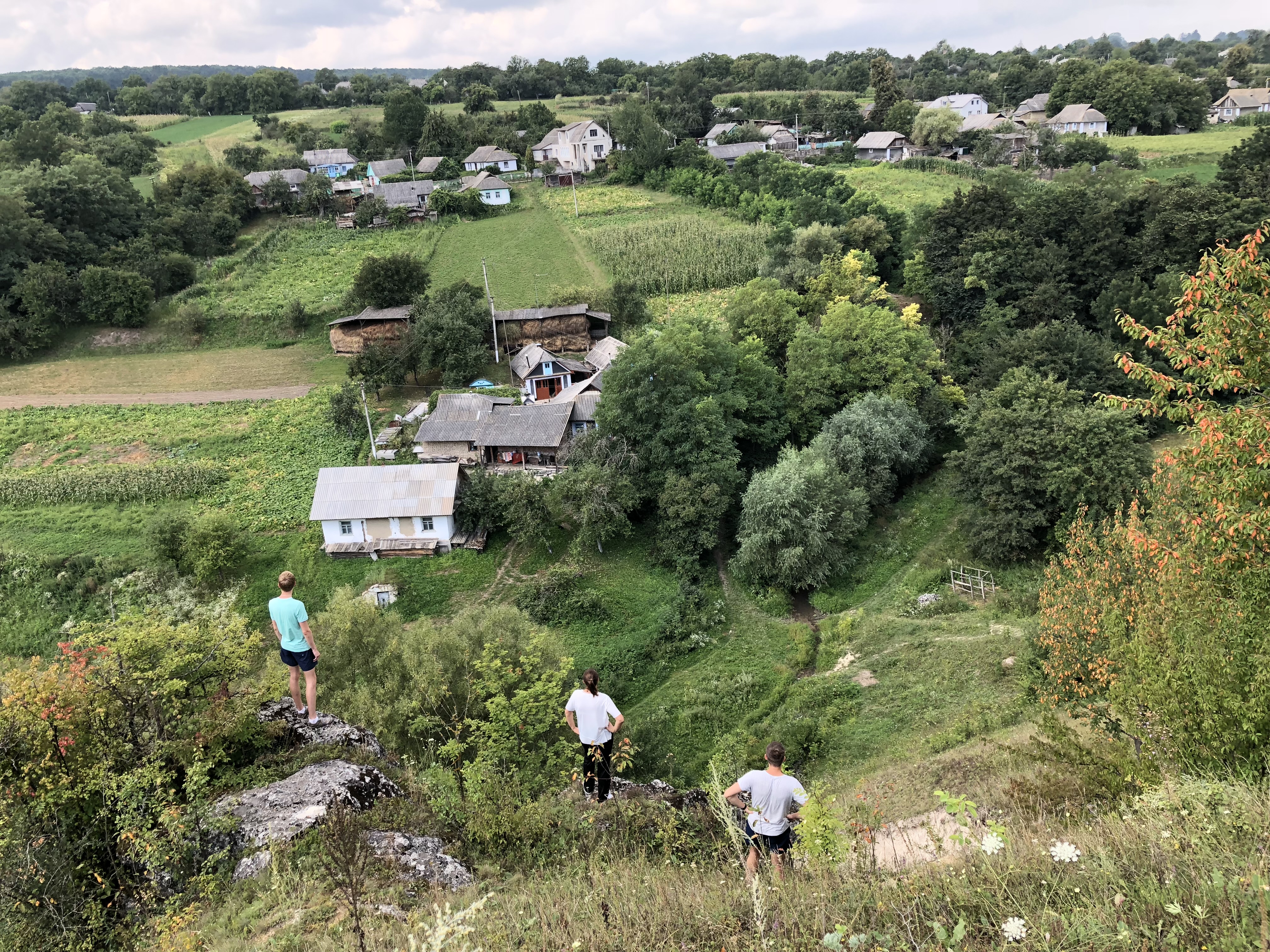 Moroziv village
Moroziv village
Archaeology and Ancient History
The area of modern Moroziv has been inhabited by people since ancient times. Archaeological research has revealed traces of Trypillian culture settlements (4th-3rd millennium BC) on the village territory, confirming human habitation here during the Neolithic period. These finds testify to a millennia-old tradition of settlement in these fertile Podolian lands.
Particularly interesting are the remains of an ancient fortified settlement: according to legends, 1 km north of Moroziv, in the Stavky ravine, there once existed a city called Chervonorud. Today, fragments of clay pottery, millstones and remains of fortifications of this legendary settlement are found there. Archaeologists suggest this could have been an important fortification from the Kyivan Rus period or later.
In neighboring Pidlisnyi Mukariv, not only traces of Trypillian settlement have been discovered, but also bronze Scythian arrowheads. This testifies that throughout the Bronze Age and Scythian periods (2nd-1st millennium BC), the entire region was actively inhabited by people. Probably, during the era of early Slavs and Kyivan Rus, small settlements or fortifications could have existed on Moroziv’s territory.
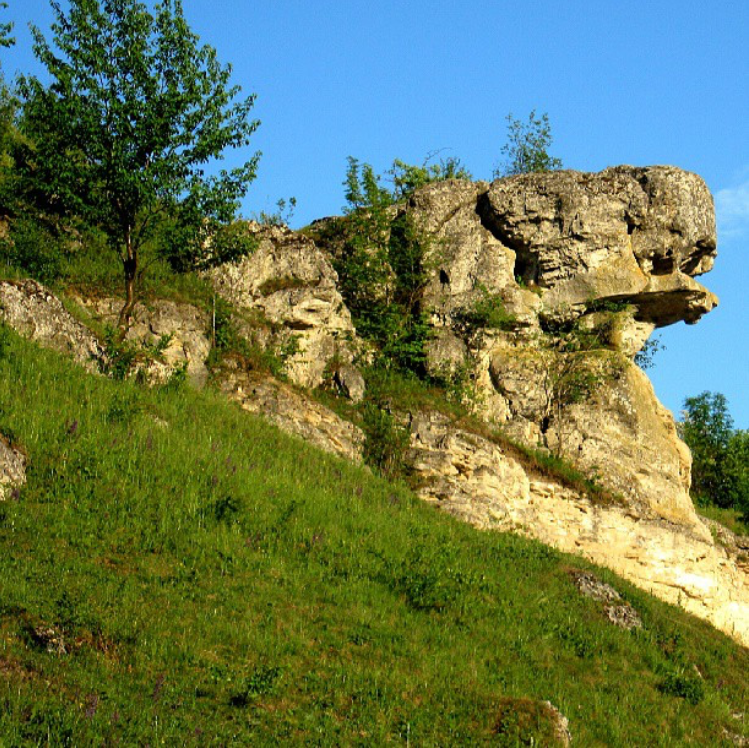 “Chubaty stone” resembling a dragon’s head in Moroziv village
“Chubaty stone” resembling a dragon’s head in Moroziv village
Village Foundation and the Morozovsky Family (16th Century)
First Documentary Mentions
Moroziv village was founded in the mid-16th century. The first written mention dates back to 1542, when the settlement appears in documents under the name Malyi Mukariv. At this time, Podolia was part of the Polish-Lithuanian state, and the lands around Mukariv belonged to the local nobility.
The Morozovsky Family - Village Founders
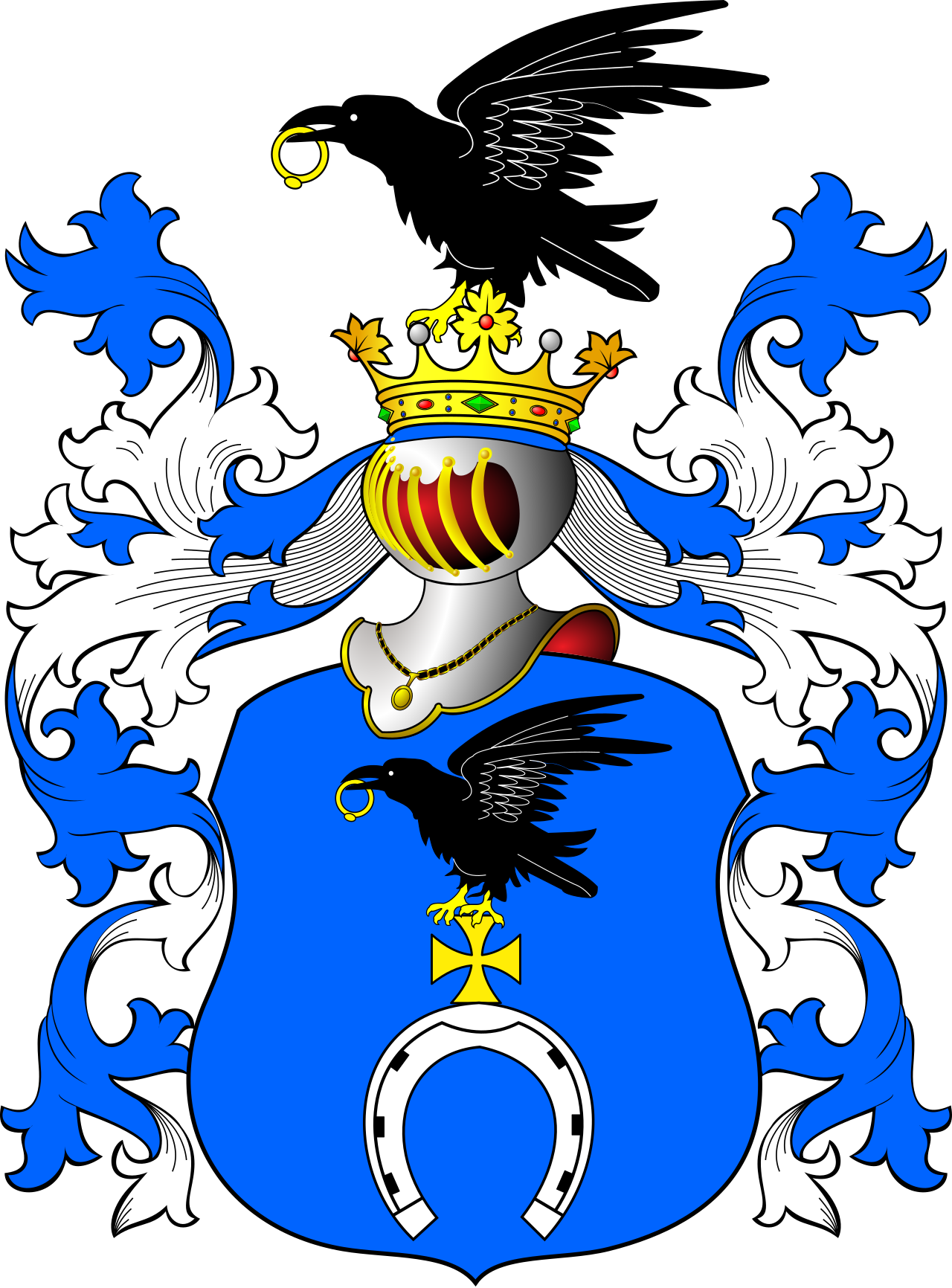 Ślepowron coat of arms
Ślepowron coat of arms
The founders and owners of the village were landowners of the Morozovsky family (Polish: Morozowski), who belonged to the ancient nobility of Podolia. The Morozovsky family used the Ślepowron coat of arms, also known as Corvin. This coat of arms was used by about a thousand noble families of the Polish-Lithuanian Commonwealth.
📖 More about the founders: Learn more about the Morozovsky family — their origins, Ślepowron coat of arms, possessions and role in founding the village.
According to the lustration of Bar starostvo in 1565, the following nobles settled in Malyi Mukariv:
- Reitko Morozovsky (founder)
- Isai Morozovsky
- Fedir Morozovsky
- Oleksii Morozovsky
Probably, this was one family – father and sons or brothers who jointly held the estate. The village foundation was carried out according to a royal privilege granted by Bernard Pretvych, the Podolian starosta of Bar. The Morozovskys received the right to settle the village on wasteland with the condition of performing service for the benefit of Bar Castle.
Origin of the Name
The original name of the settlement was Mukariv Malyi (later – Mukariv Nyzhnyi). From the surname of the owners Morozovsky comes the modern name of the village – Moroziv. In 16th-century documents, the names “Malyi Mukariv” and “Morozovtsi” were used in parallel. Only by the end of the 16th – beginning of the 17th century did the name Moroziv become established, directly indicating the owners.
Era of the Polish-Lithuanian Commonwealth (16th-18th Centuries)
Administrative Status
During the Polish-Lithuanian Commonwealth period, Moroziv (Malyi Mukariv) belonged to Kamianets county of Podolia voivodeship. The village was a private estate of the Morozovsky nobility, while neighboring Mukariv villages had different status. For example, Pidlisnyi Mukariv is mentioned as royal land already in the early 15th century, and in the mid-17th century became the center of a separate starostvo.
Turkish Occupation (1672-1699)
In the second half of the 17th century, the region experienced upheavals due to foreign invasions. In 1672-1699, Podolia was occupied by the Ottoman Empire. Although sources are silent about events specifically in Moroziv, it can be assumed that the village suffered from devastation or temporarily declined. After Podolia’s return to the Polish-Lithuanian Commonwealth (1699), the Morozovskys probably restored their rights.
Change of Owners
Throughout the 17th century, descendants of Reitko Morozovsky continued to own Moroziv. However, at the beginning of the 18th century, the Morozovsky family could have sold or lost the estate. By the beginning of the 19th century, the village already belonged to other owners – the Vilamovsky family.
🏰 New owners: Learn about the Vilamovsky family — a European noble family with various coats of arms, which owned Moroziv in the 19th century.
Russian Empire (1793-1917)
Annexation to the Russian Empire
In 1793, as a result of the second partition of Poland, the Russian Empire annexed Podolia. Moroziv became part of Podolia Governorate (administratively – Ushytsia county). In the early 19th century, the village appears in Russian statistical records under the name “Morozov” (Russian transliteration).
During this period, significant changes occurred: remnants of noble self-government were liquidated, imperial orders were introduced, and Moroziv peasants became serfs of Russian landowners.
The Vilamovsky Family - New Owners
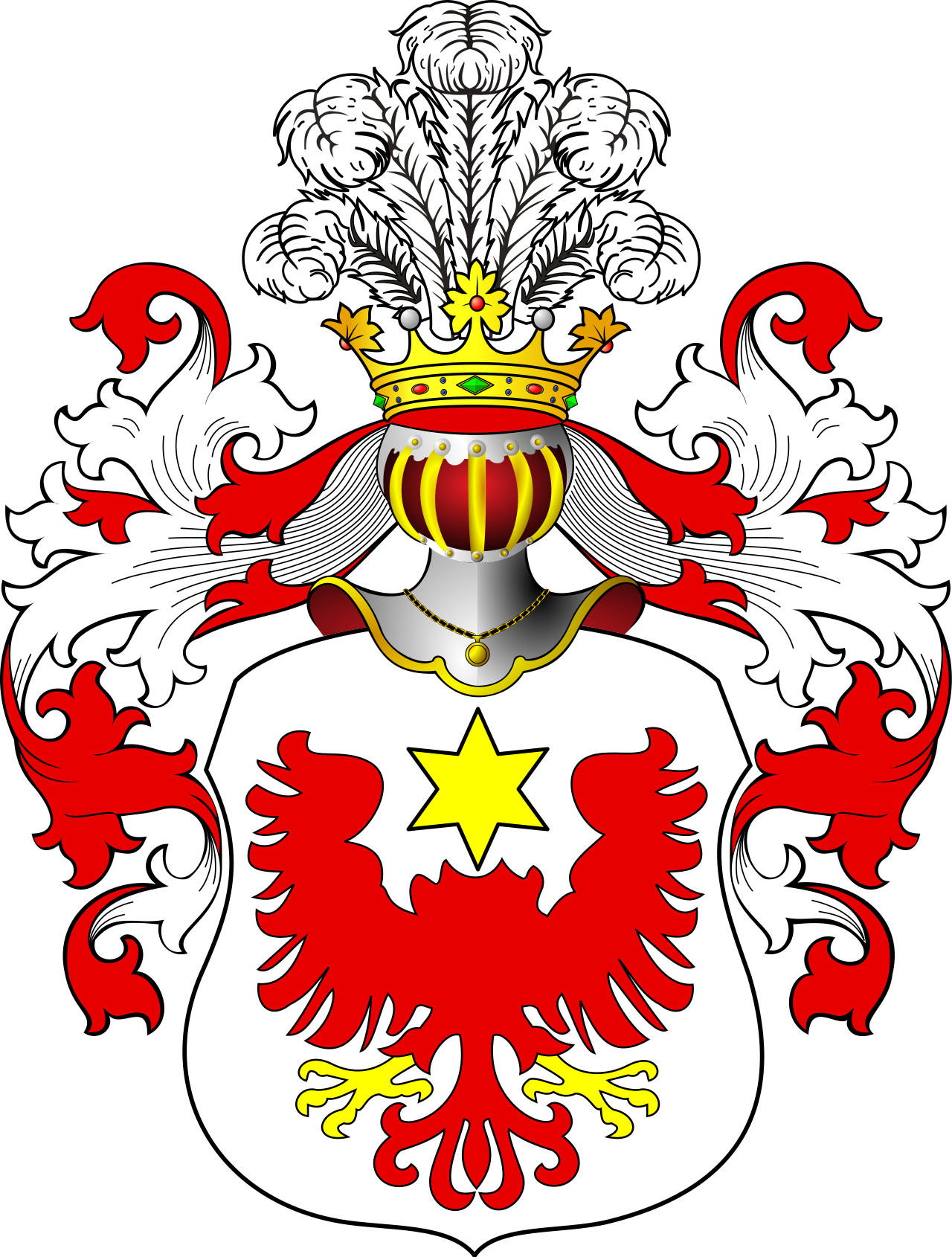 Szaszor coat of arms
Szaszor coat of arms
In the first half of the 19th century, Moroziv village belonged to Jozef and Teodor Vilamovsky – representatives of ancient Polish-Lithuanian Commonwealth nobility. The Vilamovsky family (Polish: Wilamowski) used various coats of arms, including Orla (Szaszor) and Grzymala.
According to archival data, the Vilamovskys owned:
- Moroziv village (154 peasants)
- Neighboring Morozivska Guta (70 peasants)
Marriage with the Markovsky Family
Around 1830, an important marriage took place that determined the estate’s future fate. Adela Vilamovska (born ~1810), daughter of Teodor Vilamovsky and Karolina née Bogusz, married Mateusz Markovsky – a representative of the Markovsky family of Szeliga coat of arms.
Adela brought Moroziv village as dowry to the Markovsky family. In her honor, a settlement was even founded in Moroziv – Adelina hamlet. After this marriage, the Markovskys became the new owners of Moroziv and remained so until the early 20th century.
👑 Last owners: Learn about the Markovsky family — their origins from Greater Poland, Szeliga coat of arms, life in Moroziv and the estate’s fate until 1917.
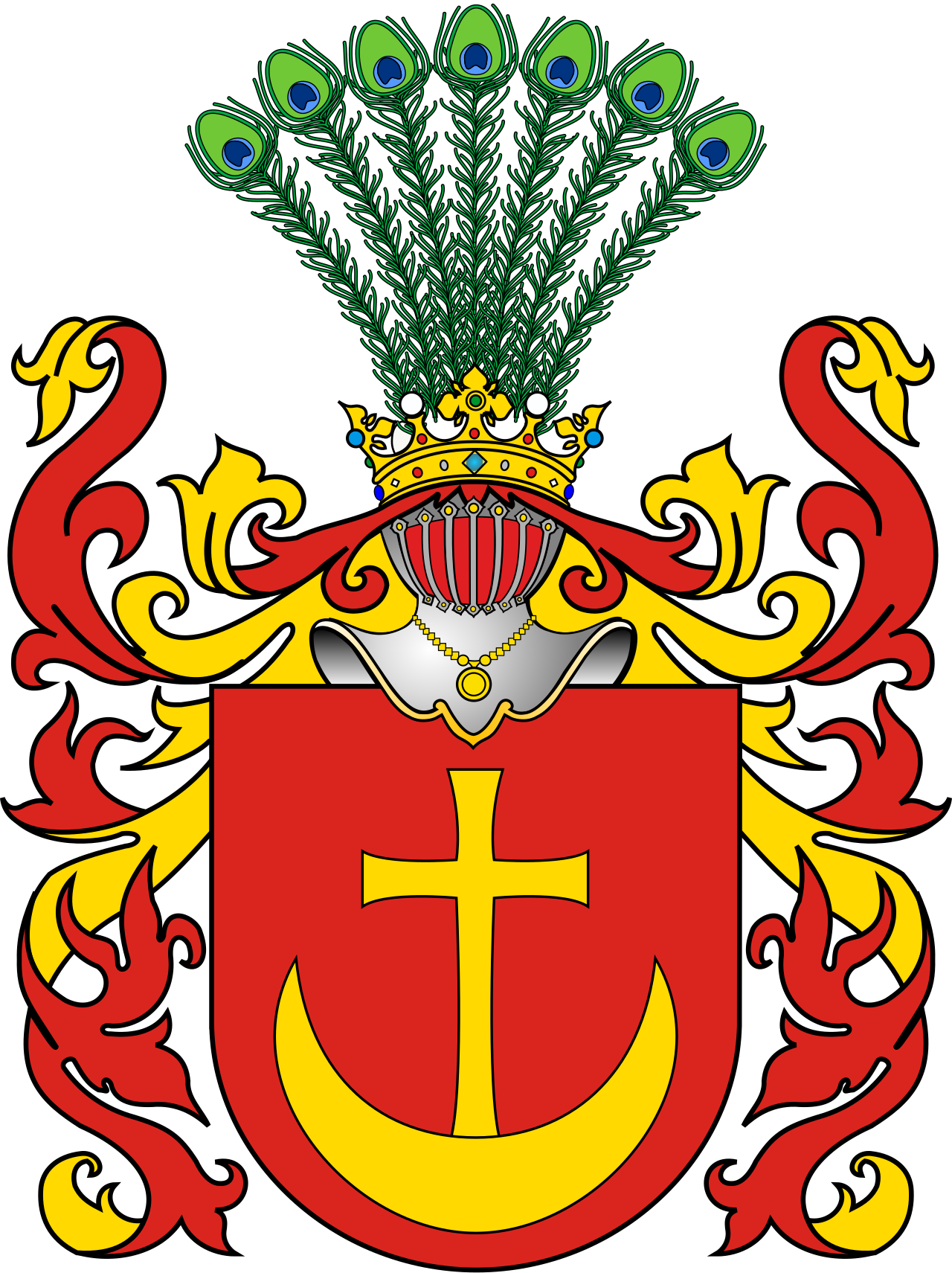 Szeliga coat of arms
Szeliga coat of arms
Village Development in the 19th Century
As of the 1880s, Moroziv (together with Maidan Morozivsky hamlet and Adelina hamlet) had 862 inhabitants, including 69 “odnodvortsy” (petty nobility). Peasants owned 549 desiatinas of land, while the landowner’s estate encompassed 1361 desiatinas.
Religious Life
In the second half of the 19th century, a new wooden Church of the Assumption of the Blessed Virgin Mary was built in Moroziv (1879-1888). It became the main religious building of the village and testified to a significant Orthodox population.
The village also had a Catholic chapel (parish in Voniakivtsi), and by the early 20th century, a Roman Catholic wooden church of St. Joseph the Betrothed is mentioned.
Peasant Reform of 1861
After the abolition of serfdom, the community gained personal freedom, although the land issue remained painful for a long time. Under the administrative reform of the 1880s, the village belonged to Dunaivtsi volost.
20th Century: Revolutions and Soviet Era
Revolutionary Events (1917-1921)
The events of World War I and the 1917-1921 revolution did not bypass Moroziv. Many peasants were mobilized into the Russian army, some died on the fronts or were captured.
After the fall of the Russian Empire, the village found itself in the whirlwind of civil war. During the UPR and Hetmanate periods, Moroziv formally belonged to the Podolia Governorate of the UPR, but power actually changed repeatedly. At the end of 1920, Soviet power was established, and the village became part of Kamianets-Podilsky okrug of the Ukrainian SSR.
Loss of Estate by the Markovskys
After the revolutionary events of 1917, noble estates were confiscated. Vladislav Markovsky (son of Mateusz), the last owner of Moroziv, was forced to leave the estate. The manor house was used for public needs during the Soviet period.
Collectivization and Repressions
First Collective Farm
In 1923, one of the first agricultural cooperatives in Podolia was organized in the village under the name “Red Plowman”. Initially, this was a voluntary cooperative association of several poor households.
Dekulakization
At the end of the 1920s, forced collectivization began. All peasants were driven into the collective farm, and wealthy farmers were subjected to dekulakization. The wealthiest families were exiled to Siberia or special settlements. Such repressions painfully struck the community – dozens of village residents suffered persecution.
Holodomor of 1932-1933
Simultaneously with forced collectivization, the region was engulfed by the Holodomor of 1932-1933. Due to grain procurement and confiscation of food from peasants, Moroziv suffered from mass famine. Many people died from exhaustion. Old-timers preserved memories of cases of entire families dying from starvation.
”Great Purges”
In the second half of the 1930s, Stalin’s “great purges” reached Moroziv. Several peasants were groundlessly arrested by the NKVD and shot or sent to camps on charges of “sabotage” or “counter-revolutionary activity.” The names of the repressed were later entered into the National Register of Victims of Political Repressions.
Collective Farm Achievements
At the same time, the collective farm continued to function. In 1939, the Moroziv collective farm even became a participant in the All-Union Agricultural Exhibition in Moscow, which testifies to certain achievements of peasants in livestock or horticulture.
World War II (1941-1944)
Occupation
In July 1941, the village was occupied by Nazi troops as part of the “Ukraine” Reichskommissariat. The occupation lasted more than two and a half years – until spring 1944. During this time, the Nazis inflicted damage on the village: they took away part of the collective farm livestock and destroyed farm buildings. Some residents, especially youth, were taken to work in Germany.
Liberation
In March 1944, during the Proskurov-Chernivtsi offensive operation, Red Army units drove the Germans out of Moroziv, and the village was liberated.
War Participation
More than 300 residents of Moroziv were mobilized into the Red Army and courageously fought on the fronts. 114 village natives received orders and medals of the USSR for combat merit. Dozens of Moroziv men died in battles, which is commemorated by a mass grave of soldiers and an obelisk of Glory in the village center.
Post-War Reconstruction
After the war, economic reconstruction began. The Moroziv collective farm was renamed “Paris Commune” and also united neighboring hamlets. The farm specialized in crop production and meat-dairy livestock farming. There were about 989 hectares of arable land.
Achievements
For high fruit yields, local gardener L.A. Slobodian was awarded the Order of Lenin in 1966. In the 1950s-1960s, new farms, threshing floors, a village club were built in the village, and electrification and radio broadcasting were carried out.
Population and Infrastructure
According to the 1970 census, about 1119 people lived in Moroziv. The village had an eight-year school, club, library, paramedic-obstetric station, and even a shoemaker’s workshop.
Independent Ukraine (from 1991)
Beginning of Independence
After Ukraine gained independence in 1991, Moroziv became part of Khmelnytskyi region. The “Paris Commune” collective farm was reformed: first into a collective agricultural enterprise, and later privatized and distributed among former collective farmers.
Demographic Crisis
This led to significant unemployment – many residents lost their jobs and began looking for earnings outside the village. The population began to decline rapidly:
- 1989 – 859 people
- 2001 – 734 people
- 2022 – 530 residents
Over three decades of independence, the village population decreased by approximately half.
Administrative Reforms
On August 13, 2015, Moroziv village council (together with subordinated villages Hamarnia and Guta-Morozivska) was merged with neighbors into the Novodunaivetska settlement territorial community.
After the 2020 administrative reform, Dunaivtsi district was liquidated, and Moroziv became part of the enlarged Kamianets-Podilsky district of Khmelnytskyi region.
Archival Materials and Sources
Cartographic Materials
Moroziv village is detailed on Russian military-topographic maps of the late 19th century (scale ~1:126,000). The maps show roads, rivers, churches and even mills. Moroziv lay on the right bank of the Ushytsia river, at the confluence of the Ushka tributary.
Metric Books
For genealogy researchers, church metrics of Moroziv village are available. St. Simeon’s Church kept metric books from at least 1772. The Central State Historical Archive of Ukraine preserves a consolidated volume of metric books for 1772-1799.
Revision Lists
The village appears in revision lists of Podolia Governorate:
- 7th revision (1816)
- 8th revision (1834)
- 9th revision (1850)
- 10th revision (1858)
Modern Village Life
Infrastructure
Operating in Moroziv:
- General education gymnasium (nine-year school)
- Club (house of culture) and library
- Paramedic station
- Several farming enterprises
Economy
The older generation engages in personal peasant farming – keeping cows, cultivating gardens. Several farming enterprises operate, renting distributed lands and growing grain crops.
Cultural Monuments and Landmarks
Church of the Assumption of the Blessed Virgin Mary
The wooden church built in 1879 is the architectural and spiritual heritage of Moroziv. One of the few surviving old churches in the Dunaivtsi area that survived the Soviet period and is now restored for worship.
Monument to Fellow Villagers-Soldiers
Erected in the village center in honor of those who fell in World War II. The names of fallen countrymen are engraved on it.
Botanical Nature Monument “Morozivska Dacha”
A forest area south of the village, protected by the state as a nature reserve. This is a large hornbeam forest with karst caves where phosphorites were once mined.
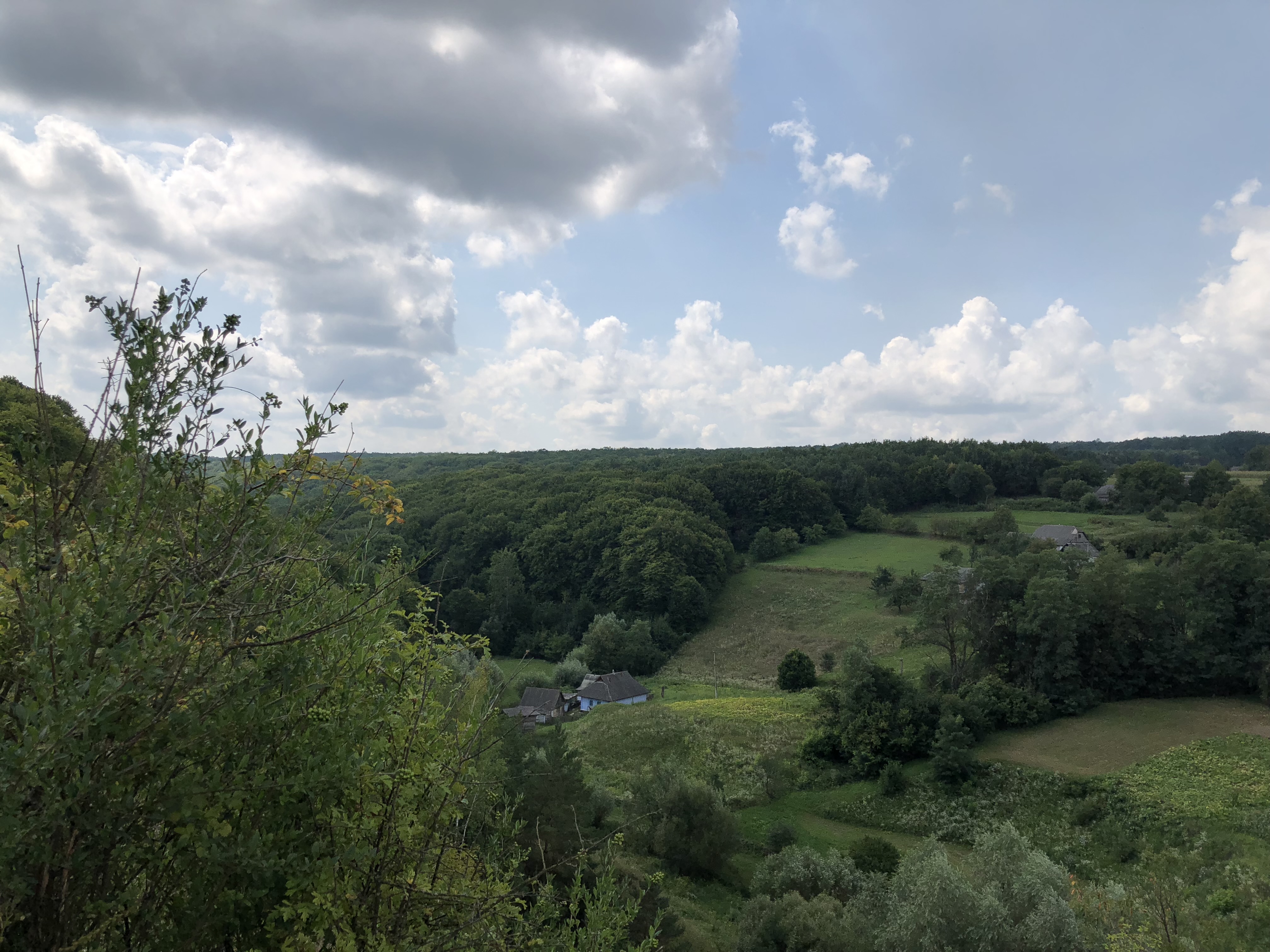 Hornbeam forest in Moroziv village
Hornbeam forest in Moroziv village
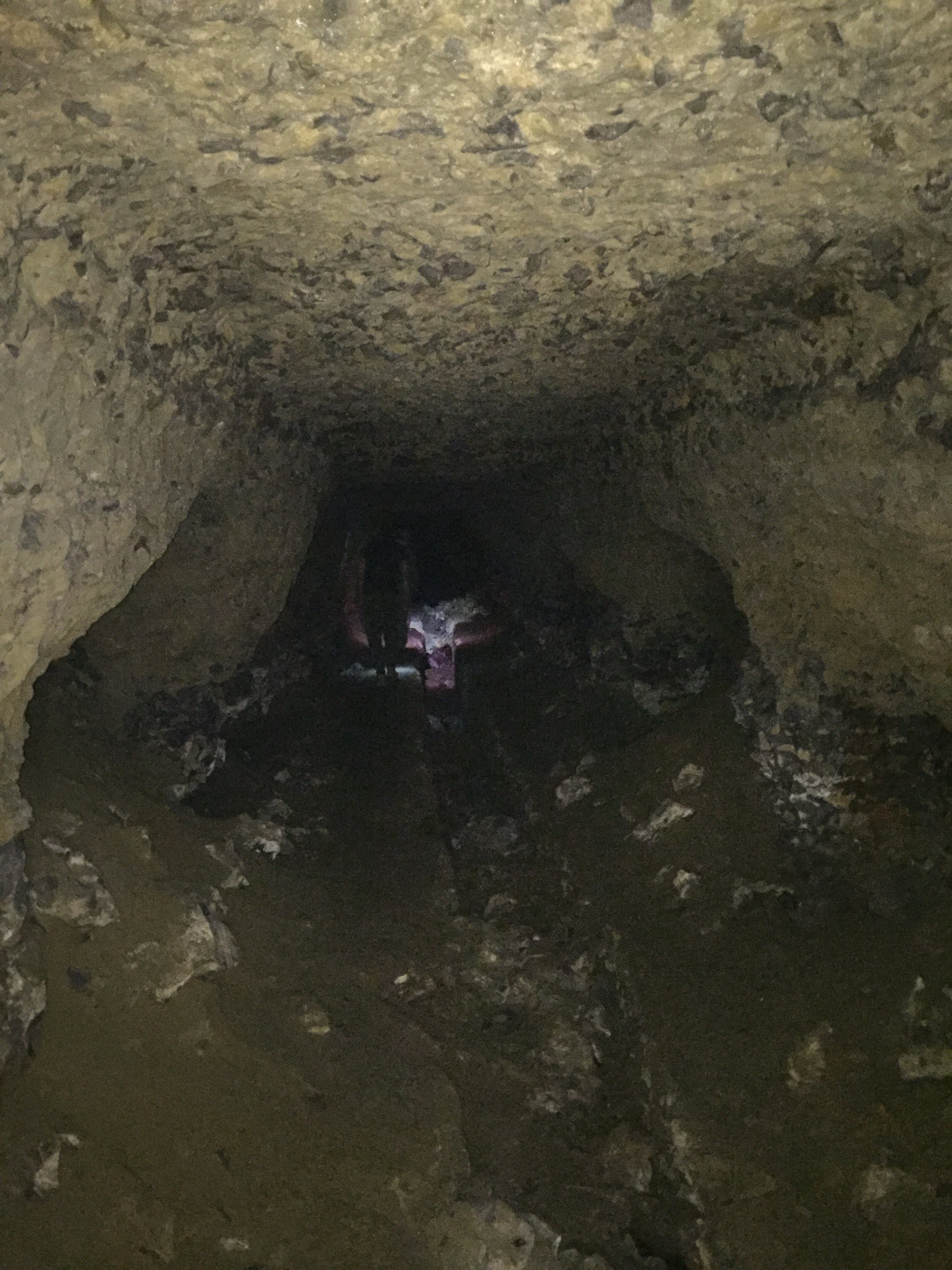 Karst caves in Moroziv village
Karst caves in Moroziv village
Remains of the Manor House
A modest one-story 19th-century manor built by the Markovskys has been preserved (now converted into a children’s facility). Two masonry gates from the early 20th century have also been preserved.
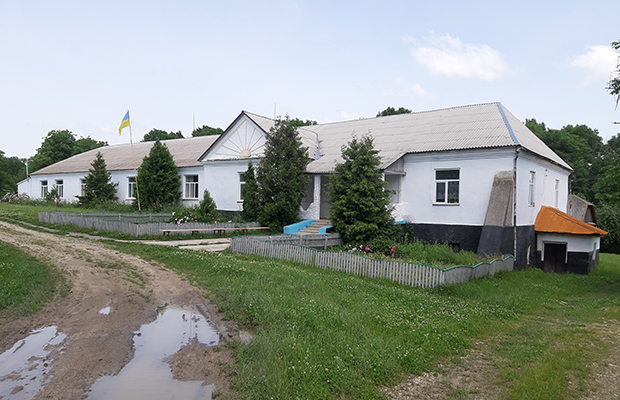 Photo by Dmytro Antoniuk
Photo by Dmytro Antoniuk
Toponyms and Memory of the Past
From former life, names of corners and ravines have been preserved:
- Morozivka – southeastern part of the village along Stavky stream
- Guta-Morozivska – former hamlet where a glassworks operated
- Adelina hamlet – named in honor of Adela Vilamovska
Unfortunately, Hamarnia village, which was subordinated to Moroziv, has become depopulated in our time – the last residents left in the 1980s.
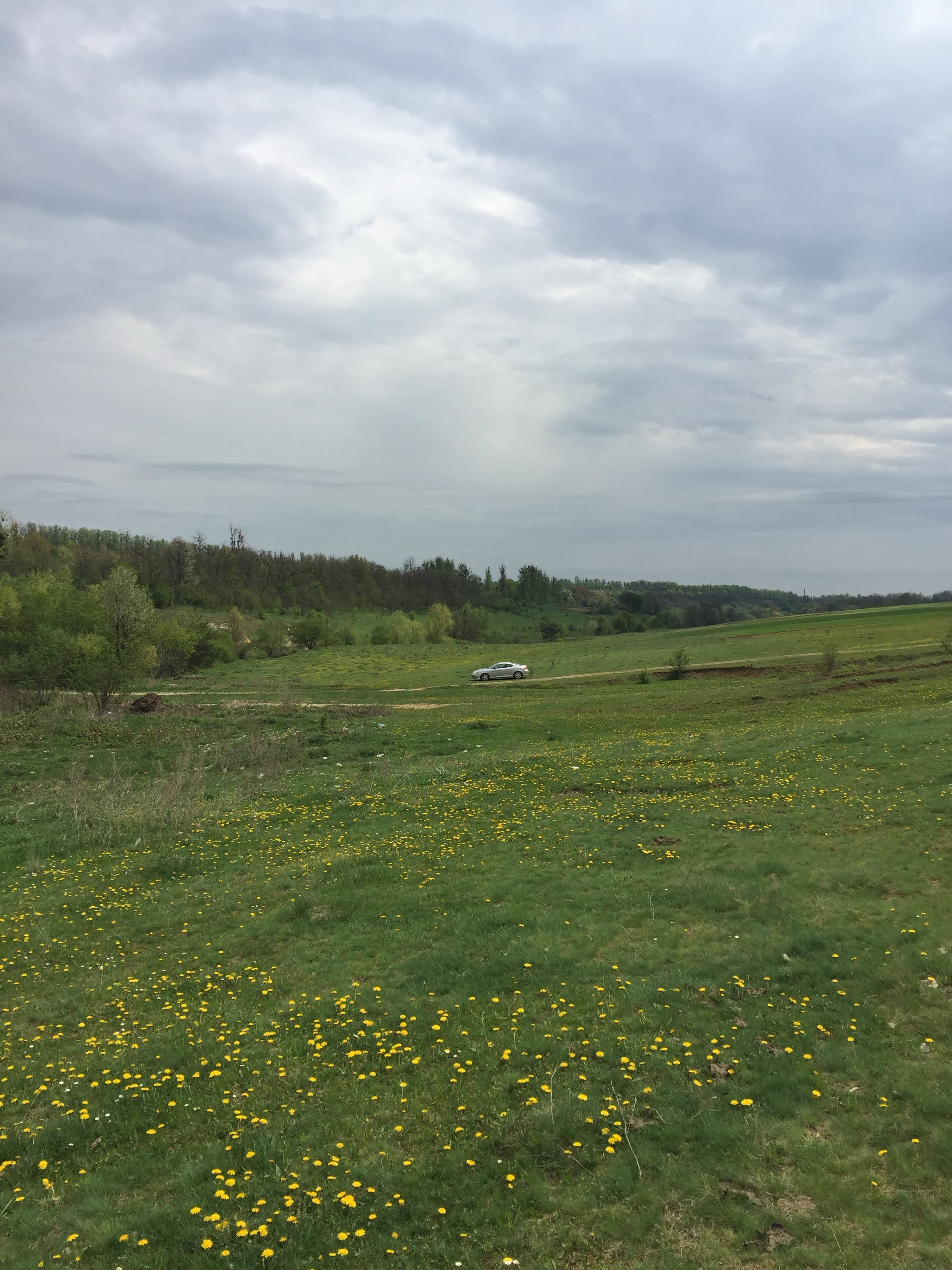 Moroziv village
Moroziv village
Conclusion
Today Moroziv is a cozy Podolian village with half a thousand residents and a rich millennia-old history. The village has traveled a path from ancient Trypillian settlements through noble estates of the Morozovskys, Vilamovskys and Markovskys to a modern Ukrainian community.
The history of Moroziv is a cross-section of the history of all Podolia: archaeological cultures, princely era, Polish-Lithuanian rule, Turkish occupation, Russian Empire, Soviet repressions and reconstruction, and finally – independent Ukraine with its challenges and hopes.
The community maintains local traditions, celebrates church holidays, preserves the memory of its history and revives spirituality. Moroziv continues to exist as a distinctive Podolian village with hope for a better future for the next generations.
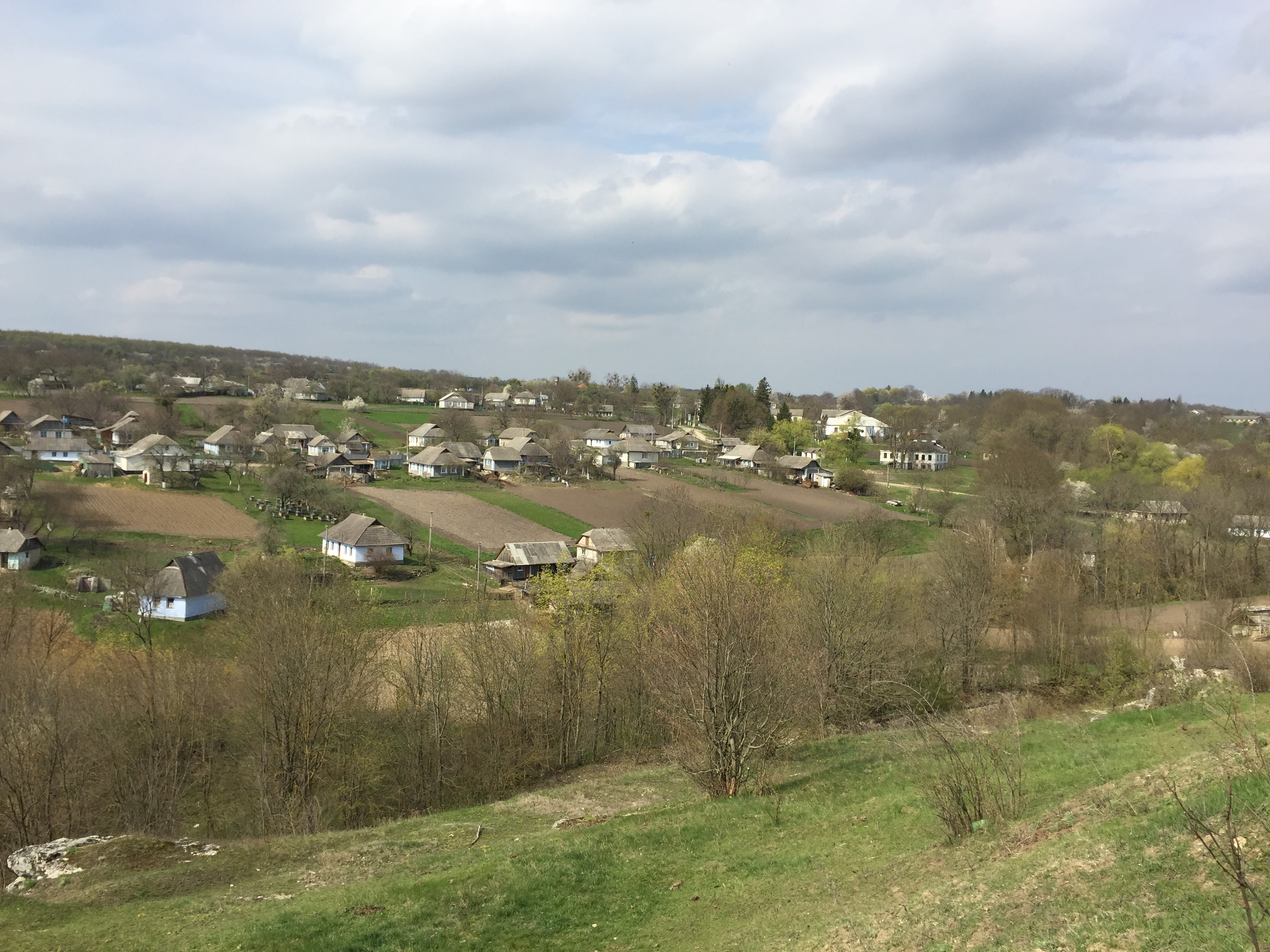 Moroziv village
Moroziv village
Sources and References
Archaeology and Historical Materials
- Archaeology and Ancient History of Dunaivtsi District - Castles and Fortresses of Ukraine
- Moroziv, Dunaivtsi District - History of Cities and Villages of the Ukrainian SSR
- Moroziv — Wikipedia
Local History Publications
- Pidlisnyi Mukariv. Masterful Neo-Gothic - Ukraine Incognita
- Moroziv. Church of the Assumption - Orthodox Glory
- Depopulated Village on the Map of Khmelnytskyi Region - Suspilne Khmelnytskyi
Archival Materials and Genealogy
- Metrics of Moroziv Village, Podolia Governorate - Metric Books of Ukraine
- Revision Tales - Catalog of Metric Books of Ukraine - Genealogy
- Geographical Dictionary of the Kingdom of Poland - ICM Digital Library
Historical Maps and Topography
- Military-Topographic Map of Podolia Governorate - Institute of History of Ukraine NASU
- Atlas of Russian Empire (1800). Podolia governorate - Wikimedia Commons
Archives
- Cartographic Collection AGAD - Central Archive of Historical Records (Warsaw)
- From the History of Podolia Monuments - State Archive of Khmelnytskyi Region
Noble Families and Genealogy
- Forgotten Polish Possessions of Kyiv Land, Podolia and Volhynia - New Galician Courier